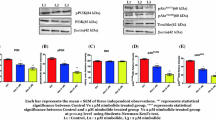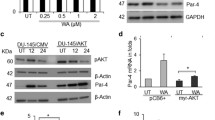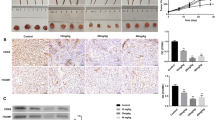Abstract
Background
The development of prostate cancer from a clinically localized, hormone-naive state to a hormonerefractory phenotype involves a complex interplay of protein kinase C (PKC) and activator protein-1 (AP-1). Therefore, the present study aimed to uncover the roles of PKC and AP-1 through midostaurin-mediated regulation—a multi-target protein kinase inhibitor.
Methods
Androgen Receptor-negative, hormone-refractory prostate cancer cells (PC-3) were used as an in-vitro model system. The effect of midostaurin on cell viability was assessed by an MTT assay. Expression studies on PKC-α, PKC-d, different AP-1 transcription factors, and AP-1 regulating genes were analyzed by semiquantitative RT-PCR, and protein levels of Bcl-2 were evaluated by western blotting.
Results
Midostaurin decreased the viability of hormone-refractory PC-3 cells. Furthermore, midostaurin significantly induced the transcripts of apoptotic-mediated PKC-d, tumor suppressor p53, cell cycle inhibitor p21cip1/waf1, death receptor TNF-α, pro-apoptotic Bax, and Caspase-8, and eventually inhibited the expression of pro-survival PKC-ε, pro-oncogene c-Jun, c-Fos, Fra-1, positive growth regulator cyclin D1, and anti-apoptotic Bcl-2. In addition, midostaurin also decreased the protein expression of anti-apoptotic Bcl-2.
Conclusion
The present study provided evidence that midostaurin suppresses tumor growth and induces apoptosis in hormone-refractory PC-3 cells via modulation of PKC-d and PKC-ε expression, and regulation of PMA-altered c-Jun, c-Fos, and Fra-1 AP-1 transcription factors and their target genes involved in cell cycle regulation (cyclin D1, p53, p21, Bcl-2, and TNF-α). Thus, pharmacological targeting of PKC and AP-1 factors may have therapeutic potential against hormone-refractory prostate cancer.
Similar content being viewed by others
References
Angel P, Imagawa M, Chiu R, Stein B, Imbra R J, Rahmsdorf H J, Jonat C, Herrlich P, Karin M (1987). Phorbol ester-inducible genes contain a common cis element recognized by a TPA-modulated trans-acting factor. Cell, 49(6): 729–739
Aziz M H, Manoharan H T, Church D R, Dreckschmidt N E, Zhong W, Oberley T D, Wilding G, Verma A K (2007). Protein kinase Cepsilon interacts with signal transducers and activators of transcription 3 (Stat3), phosphorylates Stat3Ser727, and regulates its constitutive activation in prostate cancer. Cancer Res, 67(18): 8828–8838
Babu R L, Naveen Kumar M, Patil R H, Devaraju K S, Ramesh G T, Sharma S C (2013). Effect of estrogen and tamoxifen on the expression pattern of AP-1 factors in MCF-7 cells: role of c-Jun, c- Fos, and Fra-1 in cell cycle regulation. Mol Cell Biochem, 380(1-2): 143–151
Bahlis N J, Miao Y, Koc O N, Lee K, Boise L H, Gerson S L (2005). Nbenzoylstaurosporine (PKC412) inhibits Akt kinase inducing apoptosis in multiple myeloma cells. Leuk Lymphoma, 46(6): 899–908
Basu A, Sivaprasad U (2007). Protein kinase Cepsilon makes the life and death decision. Cell Signal, 19(8): 1633–1642
Blumberg P M, Jaken S, König B, Sharkey N A, Leach K L, Jeng A Y, Yeh E (1984). Mechanism of action of the phorbol ester tumor promoters: specific receptors for lipophilic ligands. Biochem Pharmacol, 33(6): 933–940
Bradford M M (1976). A rapid and sensitive method for the quantitation of microgram quantities of protein utilizing the principle of proteindye binding. Anal Biochem, 72(1-2): 248–254
Brodie C, Blumberg P M (2003). Regulation of cell apoptosis by protein kinase c delta. Apoptosis, 8(1): 19–27
Carter C A, Kane C J M (2004). Therapeutic potential of natural compounds that regulate the activity of protein kinase C. Curr Med Chem, 11(21): 2883–2902
da Rocha A B, Mans D R A, Regner A, Schwartsmann G (2002). Targeting protein kinase C: new therapeutic opportunities against high-grade malignant gliomas? Oncologist, 7(1): 17–33
Edwards J, Bartlett J M S (2005). The androgen receptor and signaltransduction pathways in hormone-refractory prostate cancer. Part 2: Androgen-receptor cofactors and bypass pathways. BJU Int, 95(9): 1327–1335
El Fitori J, Su Y, Büchler P, Ludwig R, Giese N A, Büchler M W, Quentmeier H, Hines O J, Herr I, Friess H (2007). PKC 412 smallmolecule tyrosine kinase inhibitor: single-compound therapy for pancreatic cancer. Cancer, 110(7): 1457–1468
Fabbro D, Ruetz S, Bodis S, Pruschy M, Csermak K, Man A, Campochiaro P, Wood J, O’Reilly T, Meyer T (2000). PKC412–a protein kinase inhibitor with a broad therapeutic potential. Anticancer Drug Des, 15(1): 17–28
Fischer T, Stone R M, Deangelo D J, Galinsky I, Estey E, Lanza C, Fox E, Ehninger G, Feldman E J, Schiller G J, Klimek V M, Nimer S D, Gilliland D G, Dutreix C, Huntsman-Labed A, Virkus J, Giles F J (2010). Phase IIB trial of oral Midostaurin (PKC412), the FMS-like tyrosine kinase 3 receptor (FLT3) and multi-targeted kinase inhibitor, in patients with acute myeloid leukemia and high-risk myelodysplastic syndrome with either wild-type or mutated FLT3. J Clin Oncol, 28(28): 4339–4345
Griner E M, Kazanietz M G (2007). Protein kinase C and other diacylglycerol effectors in cancer. Nat Rev Cancer, 7(4): 281–294
Hegde S M, Kumar MN, Kavya K, Kumar KMK, Nagesh R, Patil R H, Babu R L, Ramesh G T, Sharma S C (2016). Interplay of nuclear receptors (ER, PR, and GR) and their steroid hormones in MCF-7 cells. Mol Cell Biochem, 422(1-2): 109–120
Hess J, Angel P, Schorpp-Kistner M (2004). AP-1 subunits: quarrel and harmony among siblings. J Cell Sci, 117(Pt 25): 5965–5973
Kavya K, Kumar M N, Patil R H, Hegde S M, Kiran Kumar K M, Nagesh R, Babu R L, Ramesh G T, Chidananda Sharma S (2017). Differential expression of AP-1 transcription factors in human prostate LNCaP and PC-3 cells: role of Fra-1 in transition to CRPC status. Mol Cell Biochem, 433(1–2): 13–26
Kawai M, Nakashima A, Kamada S, Kikkawa U (2015). Midostaurin preferentially attenuates proliferation of triple-negative breast cancer cell lines through inhibition of Aurora kinase family. J Biomed Sci, 22
Koren R, Ben Meir D, Langzam L, Dekel Y, Konichezky M, Baniel J, Livne PM, Gal R, Sampson S R (2004). Expression of protein kinase C isoenzymes in benign hyperplasia and carcinoma of prostate. Oncol Rep, 11(2): 321–326
Meshki J, Caino MC, von Burstin V A, Griner E, Kazanietz MG (2010). Regulation of prostate cancer cell survival by protein kinase Cepsilon involves bad phosphorylation and modulation of the TNFalpha/JNK pathway. J Biol Chem, 285(34): 26033–26040
Nakagawa M, Oliva J L, Kothapalli D, Fournier A, Assoian R K, Kazanietz M G (2005). Phorbol ester-induced G1 phase arrest selectively mediated by protein kinase Cdelta-dependent induction of p21. J Biol Chem, 280(40): 33926–33934
Ouyang X, Jessen W J, Al-Ahmadie H, Serio A M, Lin Y, Shih W J, Reuter V E, Scardino P T, Shen M M, Aronow B J, Vickers A J, Gerald W L, Abate-Shen C (2008). Activator protein-1 transcription factors are associated with progression and recurrence of prostate cancer. Cancer Res, 68(7): 2132–2144
Patil R H, Babu R L, Naveen Kumar M, Kiran Kumar K M, Hegde S M, Nagesh R, Ramesh G T, Sharma S C (2016). Anti-inflammatory effect of apigenin on LPS-induced Pro-inflammatory mediators and AP-1 factors in human lung epithelial cells. Inflammation, 39(1): 138–147
Propper D J, McDonald A C, Man A, Thavasu P, Balkwill F, Braybrooke J P, Caponigro F, Graf P, Dutreix C, Blackie R, Kaye S B, Ganesan T S, Talbot D C, Harris A L, Twelves C (2001). Phase Iand pharmacokinetic study of PKC412, an inhibitor of protein kinase C. J Clin Oncol, 19(5): 1485–1492
Schenk P W, Snaar-Jagalska B E (1999). Signal perception and transduction: the role of protein kinases. Biochim Biophys Acta, 1449(1): 1–24
Seger R, Krebs E G (1995). The MAPK signaling cascade. FASEB J, 9 (9): 726–735
Shaulian E, Karin M (2001). AP-1 in cell proliferation and survival. Oncogene, 20(19): 2390–2400
Teicher B A (2006). Protein kinase C as a therapeutic target. Clin Cancer Res, 12(18): 5336–5345
Wu D, Foreman T L, Gregory CW, McJiltonMA,Wescott G G, Ford O H, Alvey R F, Mohler J L, Terrian D M (2002). Protein kinase cepsilon has the potential to advance the recurrence of human prostate cancer. Cancer Res, 62(8): 2423–2429
Xiao L, Eto M, Kazanietz M G (2009). ROCK mediates phorbol esterinduced apoptosis in prostate cancer cells via p21Cip1 up-regulation and JNK. J Biol Chem, 284(43): 29365–29375
Acknowledgements
The authors wish to express their gratitude to the Department of Science and Technology-Promotion of University Research and Scientific Excellence [DST-PURSE; SR/59/Z- 23/2010/38(c)] and the University Grant Commission-Centre with Potential for Excellence in Particular Area [UGC-CPEPA; 8-2/2008(NS/PE)], New Delhi for providing financial support. The authors also wish to express their gratitude to the Department of Microbiology and Biotechnology, Bangalore University, Bengaluru for providing DST-FIST, UGC-SAP, and department facilities.
Author information
Authors and Affiliations
Corresponding authors
Rights and permissions
About this article
Cite this article
Krishnappa, K., Mallesh, N.K., Sharma, S.C. et al. Midostaurin inhibits hormone-refractory prostate cancer PC-3 cells by modulating nPKCs and AP-1 transcription factors and their target genes involved in cell cycle. Front. Biol. 12, 421–429 (2017). https://doi.org/10.1007/s11515-017-1475-x
Received:
Accepted:
Published:
Issue Date:
DOI: https://doi.org/10.1007/s11515-017-1475-x




